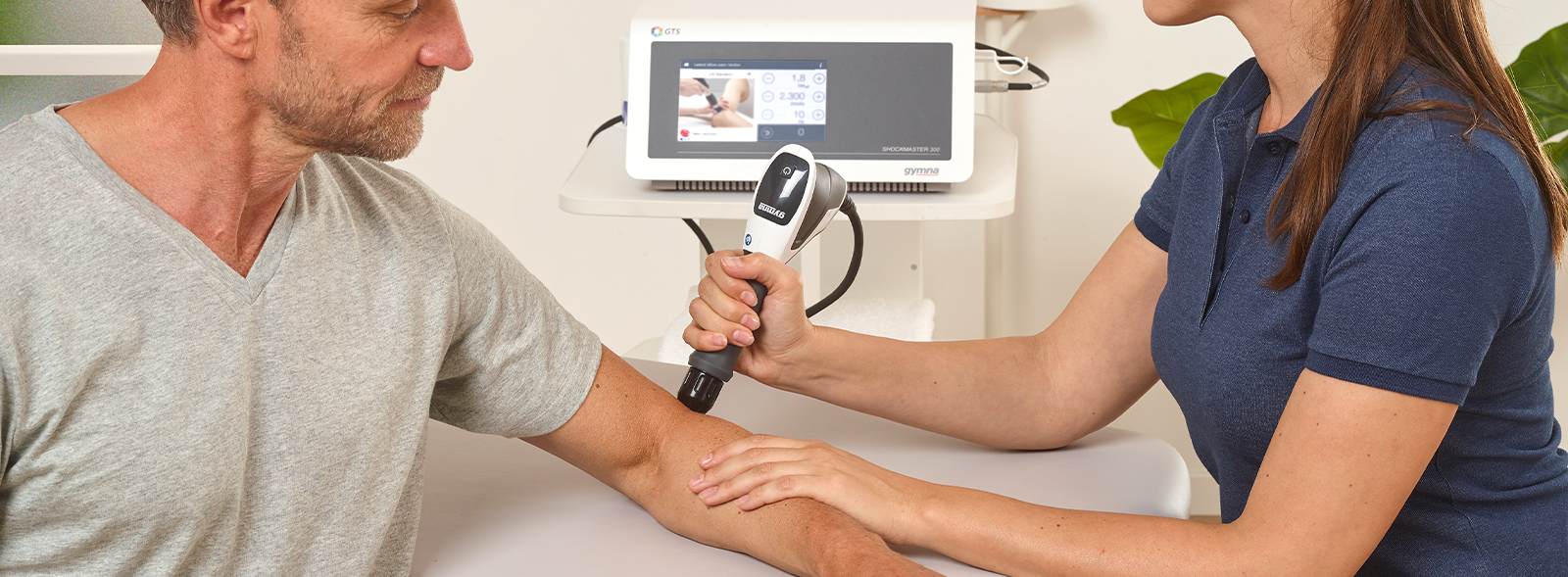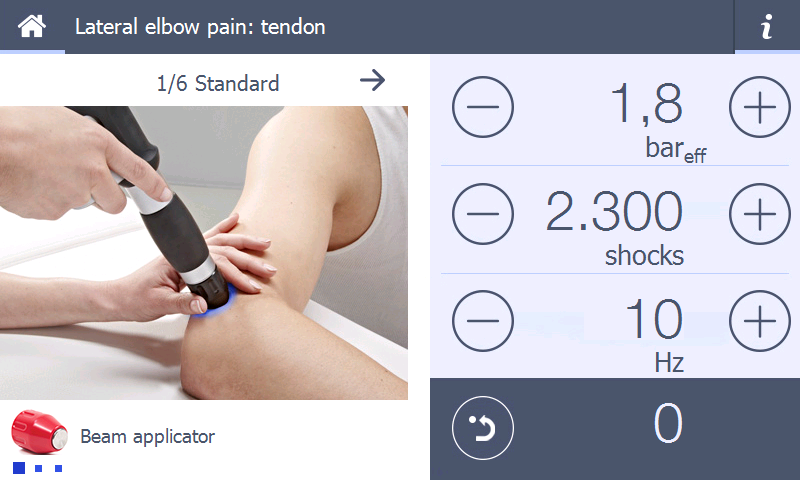How do you treat tennis elbow?
Blog 3 in a series of 3.

In the final blog in this series, we discuss three more treatment methods for tennis elbow: shockwave therapy, electrotherapy and exercise therapy. These methods are chosen on the basis of scientific research and successful treatments as experienced by therapists and patients. The combination of recommended techniques depends on each individual patient and the extent of their complaint.
Shockwave therapy for epicondylitis lateralis
Extracorporeal shockwave therapy (ESWT) is a non-invasive treatment which stimulates the body’s natural repairing process by passing short, intense sound waves in affected tissues. The main focus is on pain relief and accelerated healing. ESWT has been widely used over the last 25 to 30 years for a range of musculoskeletal conditions, and a recent meta-analysis has also provided evidence of the positive contribution that ESWT can make in the treatment of tennis elbow. ESWT is generally experienced as safe, easy to apply and relatively comfortable.
Patient Manuela: “Contrary to my expectations, the radial shockwave treatment I received from my physiotherapist was actually fine. It’s true that the treatment is quite sensitive, but I can carry on with my normal activities again immediately afterwards.

I still experience some discomfort from my tennis elbow, but it seems to improve every week, so I can always press harder before I feel any pain or tenderness.”
Shockwave therapy has been shown to stimulate the development of new blood cells, which improves circulation and tissue regeneration and reduces pain. The stimulation of nerve fibres leads to localised pain relief and the artificial disruption of the tendon tissue accelerates healing. It is a good alternative to more invasive techniques for patients who do not respond to conventional treatment methods within three months. Unfortunately, not all therapists are familiar with the possibilities of ESWT.
Physiotherapist Killian, “It’s a shame that physiotherapy courses invest so little for suitable training in the use of radial shockwave therapy for epicondylitis lateralis. Fortunately, I am supported in my clinical practice by the recommendations in literature to use either focused or radial shockwave therapy for this pathology. I estimate that my patients can resume their hobbies and work two to three weeks earlier on average following treatment with shockwave therapy.”
The effect of ultrasound and electrotherapy on tennis elbow
Electrotherapy techniques aim to reduce pain and induce cellular effects. There is a choice between five different types of energy: electric, sound, light, magnetic or thermal. There are also several treatment methods within this area, including low-level laser therapy (LLT), therapeutic ultrasound, interferential current therapy (IFC) and transcutaneous electric nerve stimulation (TENS). We briefly discuss ultrasound and interferential current therapy below.
Ultrasound is sound at a frequency that is too high for people to hear. These sound waves can penetrate deep into the tissue. Effects include raising the tissue temperature and stimulating non-thermal physiological changes, such as increasing cell permeability and encouraging cell growth. After applying ultrasound to the extensor tendon for tennis elbow, the majority of patients experience an immediate reduction in sensitivity, as patient Patrick noticed:
“I always feel relief after every physiotherapy treatment. Ultrasound definitely reduces my pain but in a different way to ice therapy techniques. It also allows me to perform the prescribed eccentric exercise therapy more easily.”
Interferential current therapy uses a medium wave frequency and is something else entirely, with various treatment options available because several parameters can be adjusted. The effects of this therapy are analgesic and can be anti-inflammatory. It also has an inhibiting effect on the sympathetic nervous system, causes local vasodilatation and stimulates the muscles.
It is only over the past few years that research into interferential current therapy for the treatment of tennis elbow has been carried out more commonly. A recent study, for example, shows that a combination of interferential current therapy and exercise therapy leads to a reduction in pain and improved grip strength. It should also be said here that the same study showed even better results for shockwave therapy in combination with exercise therapy.
Therapist Evi uses electrotherapy for the treatment of tennis elbow, but this was not yet common practice when she graduated:
“Using ultrasound and interferential current therapy was barely touched upon during my physiotherapy training, but my patients and I experience both techniques as a valuable assistive therapy in the treatment of lateral elbow pain.”
Increasing the load capacity with tennis elbow
Exercise therapy plays an essential role in the treatment of epicondylitis lateralis. As well as encouraging better blood flow, for example, which reduces pain and accelerates recovery, it also increases the load capacity for the affected structures and improves their function.
Therapist Imke: “I always include exercise therapy as part of my treatment, especially for epicondylitis lateralis.
I focus on eccentric strength exercises, not just because of their proven effectiveness in literature, but also because of my positive experiences.”
A systematic review in 2014 looked at twelve studies and they all drew almost the same conclusion, that the best outcomes are achieved by including eccentric exercises as part of the treatment. Multimodal therapy programmes which include eccentric exercises as part of the treatment produce better results in terms of pain reduction, function recovery and grip strength for patients with tennis elbow than courses of treatment without eccentric exercises.
Patient Elise: “After eight treatments for my tennis elbow, I could function much better. My therapist used various methods and they all seemed to aid my recovery. I especially appreciated the exercises in the later sessions, which appeared to strengthen the muscles in my elbow, so I could ultimately do the movements that were initially problematic for much longer.’
Combining treatment techniques for the best results
This series of blogs has looked at the following treatment methods: load reduction, TECAR therapy, dry needling, percutaneous electrolysis, the Mulligan Concept, shockwave therapy, electrotherapy and exercise therapy. This list is not complete, of course, and the fact that other types of electrotherapy, stretching, taping, manual therapy in the narrower sense and other techniques have not been discussed does not mean that they are necessarily less successful. Indeed, the best results are achieved with a combination of different treatment methods.
Therapist Guido: “My treatments for tennis elbow can all look very different. I might treat one patient with manual therapy, ultrasound and friction, and another with shockwave therapy, dry needling and stretching. My decision depends on the patient’s pattern of symptoms, and their and my experiences and preferences.”
The successes achieved by combining treatments are not something only noted by Guido, with various studies also drawing the same conclusions. For example, a systematic review in 2013 found evidence of the successful combination of stretching, muscle strengthening, ultrasound and friction treatments, as well as the combination of manipulation of the cervical and thoracic spine, concentric and eccentric exercises, and mobilisation of the wrist and elbow. The many possible combinations mean it is almost impossible to carry out a comprehensive study, however, which is why patient and therapist experiences continue to play a major role in determining the choice of treatment.
More information about shockwave and/or electrotherapy
Please do not hesitate to contact us if you have any questions or would like to receive further information or individual advice about shockwave and/or electrotherapy.
[1] Yao G, Chen J, Duan Y, Chen X. Efficacy of Extracorporeal Shock Wave Therapy for Lateral Epicondylitis: A Systematic Review and Meta-Analysis. Biomed Res Int. 2020 Mar 18;2020:2064781. doi: 10.1155/2020/2064781. PMID: 32309425; PMCID: PMC7106907.
[2] Comparison of the effectiveness of radial extracorporeal shock wave therapy and supervised exercises with neuromuscular inhibition technique in lateral epicondylitis: A randomized-controlled trial. Mustafa Çorum, Ceyhun Başoğlu, Hadi Yavuz, Cihan Aksoy Turk J Phys Med Rehab 2021;67(4):439-448. doi: 10.5606/tftrd.2021.5871
[3] Koca I, Boyaci A, Tutoglu A, Ucar M, Kocaturk O. Assessment of the effectiveness of interferential current therapy and TENS in the management of carpal tunnel syndrome: a randomized controlled study. Rheumatol Int. 2014 Dec;34(12):1639-45. doi: 10.1007/s00296-014-3005-3. Epub 2014 Apr 12. PMID: 24728028.
[4] Tarek Ammar. Extracorporeal Shock Wave Versus Interferential Current in Tennis Elbow. Biomed J Sci & Tech Res 34(3)-2021. BJSTR. MS.ID.005561
[5] Cullinane FL, Boocock MG, Trevelyan FC. Is eccentric exercise an effective treatment for lateral epicondylitis? A systematic review. Clin Rehabil. 2014 Jan;28(1):3-19. doi: 10.1177/0269215513491974. Epub 2013 Jul 23. PMID: 23881334.
[6] Hoogvliet P, Randsdorp MS, Dingemanse R, Koes BW, Huisstede BM. Does effectiveness of exercise therapy and mobilisation techniques offer guidance for the treatment of lateral and medial epicondylitis? A systematic review. Br J Sports Med. 2013 Nov;47(17):1112-9. doi: 10.1136/bjsports-2012-091990. Epub 2013 May 24. PMID: 23709519.
